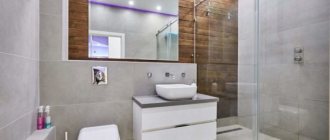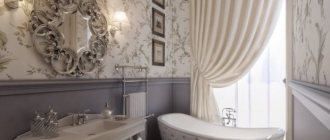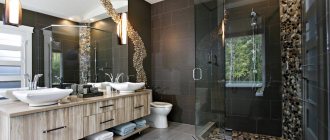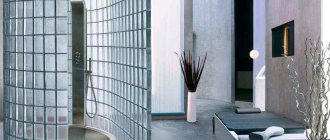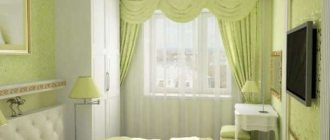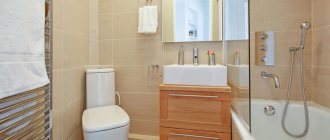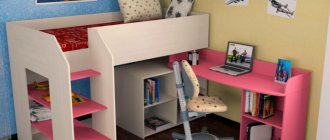A combined bathroom, shower, bath and toilet are places not only for hygiene procedures, but also for relaxation. By their decoration one can judge the wealth of the family, its culture and level of comfort. If the hallway and living room are furnished first, and more money is invested there, then you rarely get around to renovating the bathroom. As soon as the water supply or sewage system leaks, the sanitaryware becomes unusable, then the finishing of the bathroom with tiles and other materials begins. However, if you use the recommendations of specialists in choosing tiles and lay them yourself, the interior of the bathroom will look luxurious and will not cost much.
Tiling the bathroom is the best option
You can lay the tiles yourself, thereby saving your budget
Bathroom design can say a lot about its owners
Selection of tile cladding
Many people put off renovations because of the expected cost, but they can be done beautifully and inexpensively. In many families, the pressing question remains about what the bathroom should be decorated with tiles, its design and design if renovations are to be done. A balanced approach is important, since cladding walls, floors and ceilings with tiled materials should last for several years, or even a couple of decades.
The market for construction and finishing materials offers a huge range of cladding, which is classified according to several parameters. This is not only the color and size, but also the material, its properties and the purpose of the tile.
Depending on what is going to be tiled, bathroom tiles are divided into subtypes:
- for the floor (tiles are denser, harder, non-slip);
- for walls (features high decorative qualities);
- for the ceiling (light, porous, small format);
- auxiliary decor (inserts, panels, mosaic, side, frieze or plinth).
Advice. Floor tiles are most often square in shape and are characterized by increased wear resistance. On packaging it is indicated in the form of a foot print. It is best to choose middle-class porcelain tiles.
Floor tiles also differ in their coefficient of friction when wet. Class B products are less slippery, making them safer than other varieties.
There are a huge number of tile options available these days.
Choose materials based on the characteristics of the room
Ceramic tiles based on clay raw materials tend to absorb moisture and expand, so they are laid with a small gap. This ability to “breathe” is found only in natural materials, which absorb excess moisture and then gradually release it when dry.
Facing with tiles or other tiles is carried out on all surfaces or partially. Combining different types of finishes, the walls near the bathroom and washbasin are tiled, and sometimes panels are made to a certain level.
Tip: In a compact bathroom, it is inappropriate to split the finish with different colors; the room will seem even smaller. It is better to make a one-color design with a linear decorative edge to match the colored plumbing fixtures.
The disadvantage of clay-based tile material is that mold and mildew can develop in a bathroom without ventilation under heavy loads. Therefore, this issue needs to be considered for your own health and durability of the bathroom finishing when developing the design.
Clay-based tiles should be laid at short intervals
Tiles have the ability to breathe, it can expand and shrink
In a small room you should not use a lot of colors, this will make the room seem smaller
How to check tiles when purchasing
When choosing ceramic tiles, buyers focus on the brand, country of manufacture, technical and dimensional parameters, color and pattern. However, in addition to this, when purchasing, you must carefully study the information on the packaging and perform a visual inspection of the samples.
You should pay attention to the following parameters:
- Geometric accuracy of the tile shape.
- Density of ceramic structure.
- No defects on the front side.
More details on how to determine, during inspection, whether the parameters specified in the accompanying documentation for the product correspond to the real ones, are described below.
Geometry
To understand how accurate the geometric shapes of the tiles are, you should compare several samples from different packs. To do this, you need to take one sample from each pack and attach them with the back side one to the other. Tile samples must fit tightly together, the gap should not exceed 0.5 mm. If you lay out 5-6 tiles from different packs in a row, the difference in height should also not be more than 0.5 mm. Tile products from Western European manufacturers, as a rule, pass this test. The geometry of Italian, German, and Spanish tiles is exemplary.
Structure density
The density of ceramics is visually determined by looking at the reverse side. Its moisture absorption depends on the density of the tile. The higher the density of the material, the less moisture it absorbs. The water absorption coefficient is indicated by the manufacturer in the accompanying documentation, but to control it, you should inspect the back side of the tile.
High-density material is smooth to the touch, without large visible pores. There should be no more than ten small pores throughout the entire sample. If the density of the tile is small, then many pores will be visible on the back side. Such tiles will quickly absorb a critical amount of moisture, become heavy and may move away from the wall.
Front surface
The ideal surface of ceramic tiles for the bathroom is important not only because of the beauty of the appearance - it ensures durability. There should be no obvious defects on the front side: air swellings, bubbles, open pores, small cracks, tiny cobwebs. If the tile is glazed, there should be no chips at the corners and ends. Any damage to the glaze means that the tile will absorb moisture and fall off after 2-3 years of use. To examine the front surface, it is enough to selectively remove several samples from different packs.
What is important to know about facing materials
Cladding tiles have many advantages:
- large selection of finishes;
- relatively warm floor and walls;
- environmentally friendly material;
- no deformation under normal load;
- not subject to combustion;
- tolerates cleaning well with household chemicals containing abrasive particles;
- accessibility for self-repair of bathrooms and toilets;
- the possibility of partial replacement of the cladding in case of significant damage to the wall or other surface;
- variability of combination with other finishing materials;
- cannot negatively affect health;
- tolerates heat well, suitable for floor insulation with cable;
- high aesthetic properties.
Attention! To determine which surfaces the tile is suitable for, as well as what properties it has, look at the pictograms on the box. For example, there is no point in overpaying for frost-resistant or wear-resistant porcelain stoneware, which is produced for external cladding.
For repairs, buy tiles a little more than necessary in terms of square footage - with the expectation of rejection (cracks, chips, sagging and other defects). Check the batch number on each package to ensure the color, size and pattern match.
Every construction supermarket has remnants of tiles, which are offered much cheaper. Therefore, if you need single inserts for walls or floors, contact the store staff and ask for Italian tiles or marble. Broken tiles are even cheaper; they are used for mosaic panels made from pieces of tiles, glass and mirrors.
Tiles are an environmentally friendly material
Tiles have many advantages when used in the bathroom.
What and how to tile the bathroom
Tile decor is an additional opportunity to modernize the bathroom. Catalogs and construction supermarkets offer a large assortment of all kinds of ceramic sides and skirting boards, volumetric and relief inserts.
There are functional tiles in the form of stands and soap dishes, bowls and shelves, as well as tiles for decorating frames. Cameos and other sculptural images help decorate a bathroom in an antique or Empire style. For a modern style, use black glossy and colored tiles in the form of puzzles.
- For floor coverings, you can choose plain or colored tiles, as well as imitation stone or wood. Preference is given to floor cladding materials specially produced for these purposes, but it is permissible to finish with the same tiles (or another variety) - for the floor or walls. Porcelain tiles are more suitable, but can be combined (mosaics, tiles and ceramic tiles).
- Walls are more often covered with tiles than other surfaces, but combinations with other materials are possible. To enhance the effect of the design and decoration of the bathroom, it is recommended to alternate plain and colored tiles, use all kinds of borders and panel inserts.
- Ceiling covering is not often used in the bathroom, mainly due to condensation that forms in a poorly insulated room. Usually limited to painting. But beautiful relief cladding with tiled materials is aesthetic and practical.
- Countertops, columns and other auxiliary surfaces are most often treated with small mosaic tiles on a flexible base, produced in rolls. It is convenient for covering radial planes and curved surfaces. This cladding looks very organic in a mini-pool, shower and combined bathroom. The tiles also go well with countertops made of glass, acrylic, natural stone or its imitation.
- The niche or back area under the bathtub is also often covered with tiles, having previously arranged a closed podium (with steps, solid or with sliding doors). The closed space under the tank is often decorated with mosaic or pictorial panels.
Manufacturers offer a huge number of decorative edges, skirting boards, etc.
A bathroom decorated with mosaic tiles will look very beautiful.
Finishing materials can be combined
In the design of bathrooms, tiling with imitation of natural materials looks luxurious:
- large uncut stone;
- marble and granite;
- smooth small and large pebbles;
- bamboo;
- sandstone;
- wood;
- ornamental stones and gems (tiles imitating malachite, sardonyx, opal, jasper, agate, charoite).
Not so long ago, glass and mirror tiles came into fashion. This is a great option, but it fogs up after hygiene procedures. In such a room, good ventilation is important, otherwise the surfaces will have to be wiped frequently. But such cladding provides additional opportunities for decorating the bathroom with original tiles.
For example, in a spacious room you can arrange a luminous path - the lighting turns on when you step on the blocks. You can also place foil with diodes under the glass, then the insert will sparkle like precious stones.
Decorative panels are a great way to add more personality to any room in the house. Freesize (free size) is convenient because the finished drawing applied to each fragment does not have clear boundaries. The edges of the image seem to dissipate, so it is easy to adapt it to a wall or floor of any format. The missing quadrature is compensated with any material of the same color.
In large rooms you can combine colors and patterns on the tiles
Tiles with imitation natural materials look amazing
The pattern is easy to assemble and tile in the bathroom. Designers suggest placing such inserts in the shower, above the bathtub, mini-pool or jacuzzi. Decorative inserts in a contrasting color will transform your bathroom interior beyond recognition. This kind of renovation looks luxurious, even if you do it yourself.
When choosing tiles, also keep in mind that the glossy texture of light shades adds light, while black matte tiles absorb space. The deepest color is considered to be blue and cyan, and the feeling of comfort is added by beige as a background and a warm range of the spectrum. A seamless option and colored sanitaryware of an unusual shape, as in the photo, will add luxury.
Types of finishes for the bathroom
TABLE
| 1. | Monocottura | Single-fired ceramic-based tiles, quite durable, suitable for floor installation. |
| 2. | Bicottura | Double fired glazed squares, quality and style for walls and ceilings, glossy and matt. |
| 3. | Metlakhskaya | Smooth, strong, durable, high quality double fired cladding for ceilings and walls, easy to clean. |
| 4. | Porcelain and earthenware | Expensive, beautiful, made from special raw materials, polished tiles with a dense structure and high durability. |
| 5. | Ceramic | Inexpensive popular material, known for its durability, but the most attractive. |
| 6. | Majolica | The material has a pressed base with a picturesque glaze pattern and absorbs moisture. |
| 7. | Porcelain tiles | Durable artificial stone, produced in the form of imitation of natural textures. When laying, there are difficulties with cutting; you need a waterjet machine. |
The choice of finishing material depends on the budget and features of the room
Ceramic tiles are the most popular material for bathroom decoration
Finishing materials can be combined
Apron over work surfaces: beginner's experience
A ceramic tile apron over the work surface is a must! But when you first decide to do it, a number of questions and obstacles arise. I'll tell you my story.
The apartment we live in has something special. It is hotel-type, with its own bathroom, and a small hallway. Nobody likes living without a kitchen! Common areas are usually filled with neighbors, their conversations and cigarette smoke. We decided to overcome the layout. In the hallway, water supply and drainage was urgently organized, along with a dense electrical cable for six squares. We bought a stove and a full sink. The dimensions of the room are only 1.6 by 2.4 meters. Now it's our own kitchenette! We placed aprons above the stove and sink.
Dedicated to everyone starting renovations in old kitchens.
I hope my material will help you in your repair! Don't be afraid of anything! Starting is always difficult, but interesting. That's what the process was like.
Features of wall preparation.
Pre-measure the height of the equipment: the apron should start below this height. For us this allowance is 5 cm. The height is at your discretion. It is desirable that it be at least 50 cm. We chose this: above the sink there is a cabinet, there is a lower apron there - 60 cm. There is nothing above the stove yet (in the future we will hang a hood). It's 80 cm.
Also, measure the width and depth of the equipment (we have both the sink and stove in the corners), the length of the apron will depend on this. We made the work surface above the sink according to its dimensions. And above the stove they extended it to install a cabinet-table. A coffee maker, kettle and toaster now live there.
Stylistics of bathroom cladding
The design of a bathroom can be done in any style; it is not necessary to repeat the same solution as in the living quarters.
- Marine style is very popular for bathrooms; this theme is easily implemented. The combination of tile materials and self-leveling floors with images of corals, sea fish or dolphins looks great. Real shells and pebbles are used as decoration.
- The design solution for classic and historical styles also allows for tiled cladding. In a spacious room, a voluminous frieze near the ceiling (in the form of molding), semi-columns and voluminous sides look great. It is advisable to use imitation marble and panels in the form of frescoes. Avoid bright colors and flashy contrasts to make the design look expensive, stylish and cozy.
- The antique, empire, baroque and neo-baroque styles are luxurious (in terms of type and cost). It is advisable to invite a specialist who will draw up a design project and advise on the cladding. Bet on white, beige, gold and blue.
- Ethnic styles are less often used in bathrooms, but they look no less luxurious, especially in the spirit of the Arab East or Japanese minimalism. Today there are no problems with finding panels with a sakura branch, geishas or hieroglyphs. No less interestingly, the bathroom is decorated in a different ethnic style; it is important to choose the appropriate decor and color scheme inherent in the culture of certain peoples.
- A black and white interior with checkerboard tiling is an expressive image for Gothic or Neo-Baroque. This severity has its own attractiveness. Original lamps and black sanitaryware, stained glass or their imitation in the doors, long mirrors and chrome fittings will add coziness to the contrasting solution.
- Ecostyle is the poetry of natural textures and natural materials. Imitation of expensive wood and stone through porcelain stoneware and other tiles will reduce the cost of finishing. A 3D panel similar to photo wallpaper looks impressive; you can use an aquarium and artificial plants (there is not enough light for living things in the bathroom).
- High-tech and loft are typical urban styles, especially revered by interior designers. This is an ode to technological progress and synthetic materials with a certain carelessness in finishing. Uncovered beams and communications, imitation brickwork, a lot of plastic, metal, glass and concrete. Not everyone can do such a bathroom interior; it’s better to entrust it to professionals, otherwise it will turn out cold and lifeless.
- Scandinavian minimalism looks great in white, it doesn’t seem cold, on the contrary, there is an amazing atmosphere of simplicity and comfort. Everything is restrained, laconic and sweet. With this finish, it seems that the bathroom has become lighter and more spacious, with more light, although there are no windows.
- Provence, in contrast to high-tech, is a typical representative of country style, but with French charm. For lovers of olive, lavender and blue. But even a cold palette cannot spoil the impression of the amazing interior in a bathroom designed in the spirit of Provence.
Marine style is very popular in bathroom design
If the room is small, use light colors, this will visually increase the size of the room
In the same tone as the screen
I propose to consider this option, where the apron above the sink and the screen under the bathtub are made of the same material and in the same color. These two small elements will set the mood for the entire room.
An apron in the bathroom is a way to make the room practical, stylish and at the same time save a little on renovations. After all, using tiles only in “wet areas” will cost several times less than laying them everywhere.
Tile laying options and combined cladding
The dimensions of the room and its “stuffing” with plumbing fixtures are the key parameters when choosing finishing methods for laying tiles.
In a small Khrushchev it is very cramped, so it is better to install a washing machine under the countertop with a washbasin. It is better to replace the bulky container with a triangular bathtub or jacuzzi. You should not choose large tiles and contrasting laying, this will fragment the space.
Dilute the monochromatic solution with rare bright small-format inserts or patterned tiles. Good lighting, including the ceiling perimeter and mirror frame, will make it feel a little more spacious.
When choosing materials for finishing, every little detail plays an important role.
Walls can be decorated with drawings and patterns
Use decorative tiles, it will perfectly decorate the bathroom
A large bathroom is also considered “problematic” - it is necessary to fill all this space with functional objects so that the room does not seem lifeless or empty. Experiments with color, tile shape and type of installation are allowed here:
- classic seam to seam, checked with a plumb line and level;
- staggered (with offset seams, reminiscent of a brick wall);
- diagonally (the original way to expand the space);
- parallel stripes (it is better to do not a solid wall, but in fragments);
- modular (laying fragments of different shapes and sizes, but with a matching edge, to create an alternating pattern);
- vertical (rectangular tiles, visually raises ceilings);
- patchwork (variegated tiles with different patterns of the same format, reminiscent of a patchwork quilt);
- mosaic (a pattern is laid out from pieces of different shapes and sizes).
If the bathroom is large, you can try experimenting with colors and materials
In the bathroom you can hang a picture and put a vase of flowers
You can also experiment with surface area - tiling part of a wall or the entire space, as well as framing functional objects or a tank area. A dark bottom and a light top, a wide colored stripe in the middle or a gradient styling - with a gradual transition from a dark shade of one color to a light one - looks good. More interesting ideas are in our photo examples.
